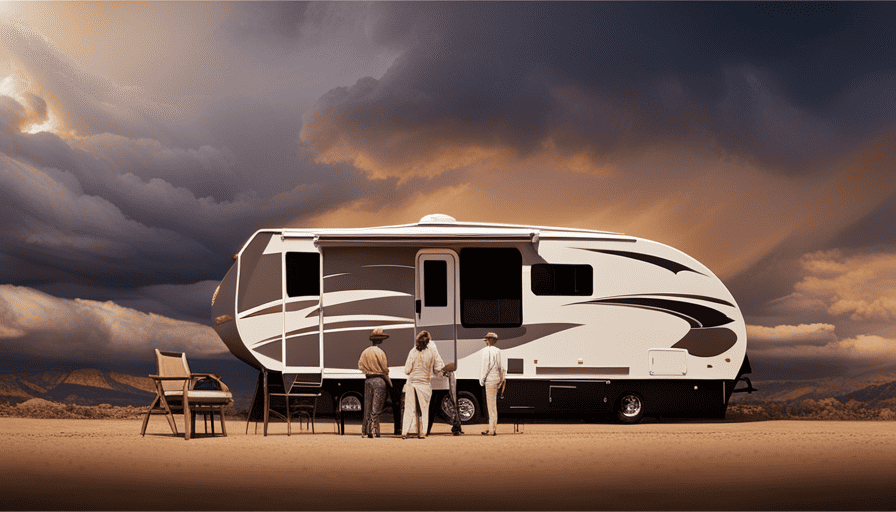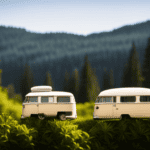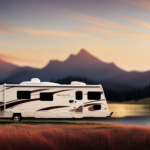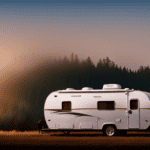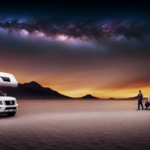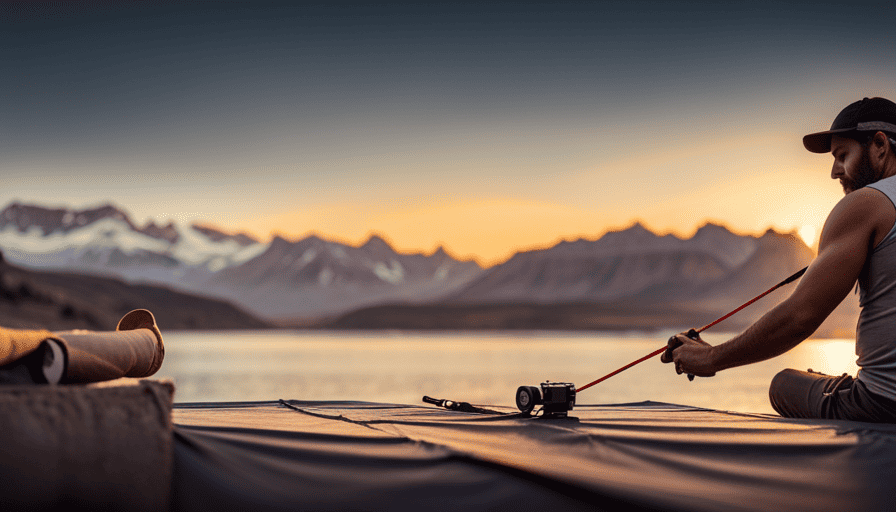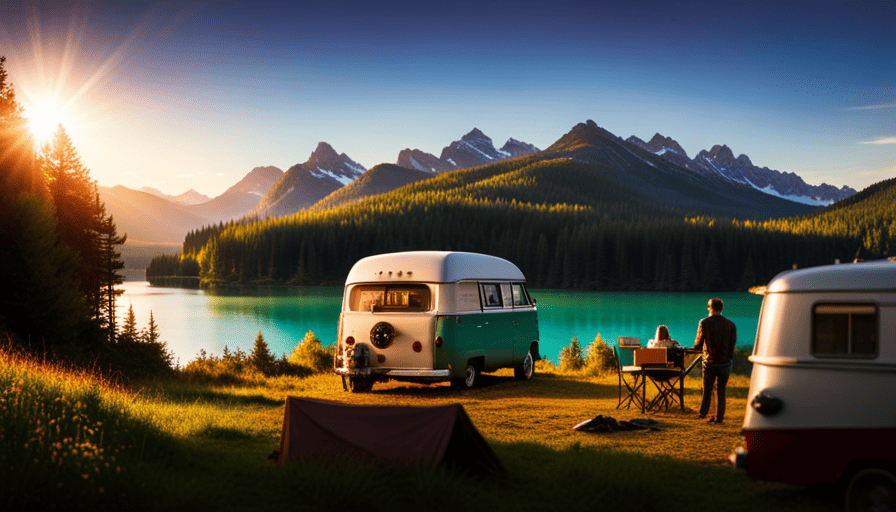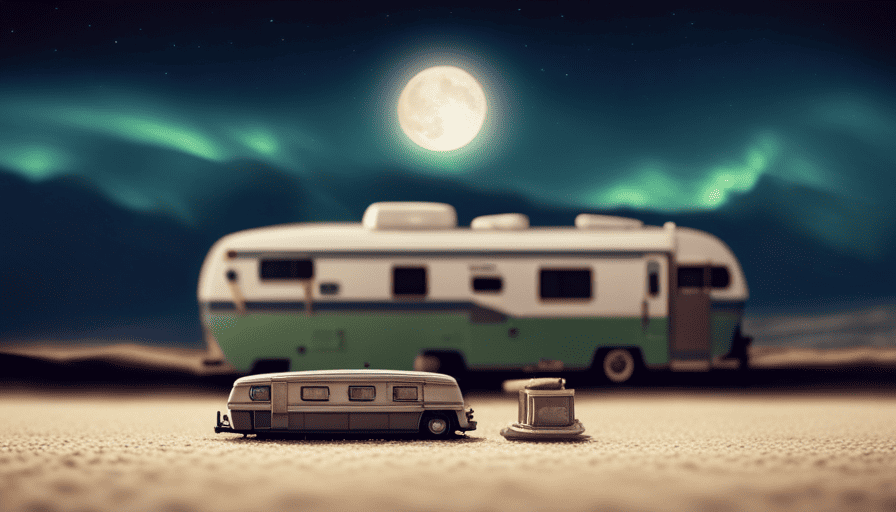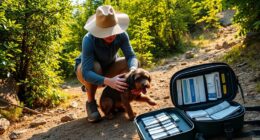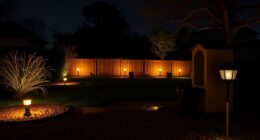Are you ready for the ultimate outdoor adventure? Before embarking on your journey, it’s crucial to be aware of one key piece of information: the height of your 5th wheel camper. Trust me, having accurate knowledge of your camper’s height is essential to ensure a smooth and hassle-free trip.
When it comes to 5th wheel campers, the height can vary depending on several factors. These factors, which I’ll delve into in this article, include the type of truck suitable for towing, potential challenges of owning a taller camper, and alternatives for low clearance situations.
But why is knowing the height so important? Well, picture this: you’re cruising down the highway, excited for your adventure, only to come face to face with a low bridge clearance. Yikes!
To avoid such a nightmare, I’ll also guide you on how to measure the height of your 5th wheel camper accurately. Plus, I’ll share some tips for choosing a camper with the right height and discuss storage and parking considerations.
So, grab a cup of coffee, sit back, and get ready to become an expert on all things 5th wheel camper height. Let’s hit the road!
Key Takeaways
- The height of a 5th wheel camper can vary depending on factors such as wheel size, suspension system, and overall design.
- Taller campers can create more wind resistance, affecting towing and fuel efficiency.
- Knowing the height of a 5th wheel camper is crucial for bridge clearance and avoiding potential hazards.
- Storage and parking considerations for 5th wheel campers include finding facilities with enough vertical clearance and checking local parking regulations.
Understanding the Height Specifications of 5th Wheel Campers
The height of a 5th wheel camper can vary, so it’s important to pay attention to the specifications before making a purchase. Understanding the height specifications of a 5th wheel camper is crucial as it can affect various factors, including towing capacity.
The height of a 5th wheel camper is determined by several factors, such as the size of the wheels, the suspension system, and the overall design.
One of the main factors affecting the height of a 5th wheel camper is the size of the wheels. Larger wheels can increase the height of the camper, while smaller wheels can lower it.
Additionally, the suspension system plays a role in determining the height. Campers with a higher suspension tend to have a greater ground clearance, resulting in increased overall height.
It’s important to consider the impact of height on towing capacity. A taller 5th wheel camper can create more wind resistance, which can make towing more challenging and affect fuel efficiency. Additionally, a taller camper may limit access to certain campsites with low hanging branches or height restrictions.
Understanding the height specifications of a 5th wheel camper is essential before making a purchase. Factors such as wheel size and suspension system play a role in determining the height. The height of the camper can impact its towing capacity and accessibility to certain campsites.
Moving forward, let’s explore the various factors that determine the height of a 5th wheel camper.
Factors That Determine the Height of a 5th Wheel Camper
To determine the height of a 5th wheel camper, you’ll need to consider a variety of factors. Understanding height limitations and adjusting the camper’s height accordingly is crucial to ensuring a safe and hassle-free camping experience. Here are three key factors that determine the height of a 5th wheel camper:
-
Trailer Height: The height of the trailer itself plays a significant role in determining the overall height of the camper. Manufacturers provide specifications on the height of the trailer, which can range from around 11 to 13 feet. It’s essential to know this measurement to determine if the camper can safely pass under bridges or other low clearance areas.
-
Hitch Height: The height of the hitch, where the camper connects to the towing vehicle, also affects the overall height. Most hitches can be adjusted to raise or lower the camper, allowing for better compatibility with different towing vehicles and accommodating height limitations.
-
Suspension and Tires: The type of suspension and tires on the camper can impact the overall height. Higher suspension or larger tires can increase the height, while lower suspension or smaller tires can decrease it.
Understanding these factors will help you determine the appropriate height for your 5th wheel camper. Knowing the height of your camper is crucial for bridge clearance, as it ensures you can safely pass under bridges without any risk of damage.
Importance of Knowing the Height for Bridge Clearance
Knowing the height requirements for bridge clearance is like having a compass to navigate the safe passage of your fifth wheel camper. Bridge height is a crucial factor to consider when planning your route. Failing to account for the height of your camper can lead to potential hazards and costly damages.
Bridges with low clearance can cause serious accidents and even result in the complete destruction of your camper. Therefore, it’s essential to know the height of your fifth wheel camper and compare it to the posted bridge heights along your route.
Bridge height restrictions can vary from one location to another, so it’s crucial to research and plan ahead. Many bridges have signs indicating their clearance, allowing you to make informed decisions. However, it’s important to remember that the posted height is not always accurate due to factors like weathering and road resurfacing. Therefore, it’s advisable to leave some margin for error and choose a route with ample clearance.
Measuring the height of your fifth wheel camper accurately is the next step in ensuring a safe journey. By knowing your camper’s height, you can confidently select routes with bridges that have sufficient clearance.
How to Measure the Height of a 5th Wheel Camper
Measuring the height of a 5th wheel camper accurately is a crucial step in ensuring a safe journey on the road. To help you measure the height of your camper correctly, here are some useful techniques:
-
Use a measuring tape: Start by extending the measuring tape from the ground to the highest point of your camper. Make sure to measure from the level ground to get an accurate reading.
-
Check the manufacturer’s specifications: The height of your 5th wheel camper may be listed in the owner’s manual or on the manufacturer’s website. This can serve as a reliable reference point. Checking the manufacturer’s specifications for the average camper height is crucial, as it can help you avoid any clearance issues when driving under bridges or through tunnels. Additionally, knowing the height of your camper can also help you select appropriate campsites with enough overhead space. It’s always better to be safe than sorry when it comes to the height of your 5th wheel camper. Another way to determine the average camper height is to measure similar models at a dealership or campground. By gathering this information, you can compare it to your own camper and make any necessary adjustments to ensure a smooth and safe towing experience. It’s important to consider the average camper height when planning your route to avoid any low clearance obstacles along the way.
-
Take note of potential height restrictions: When measuring your camper’s height, it’s important to consider potential height restrictions on certain roads, bridges, or overpasses. Taking these restrictions into account will help you plan your route and avoid any unnecessary detours.
By accurately measuring the height of your 5th wheel camper and being aware of potential height restrictions, you can ensure a smooth and safe journey.
Now, let’s explore the types of trucks suitable for towing 5th wheel campers.
Types of Trucks Suitable for Towing 5th Wheel Campers
When it comes to towing a 5th wheel camper, you’ll need a truck that can handle the weight and provide stability. This means you’ll need a heavy-duty pickup with a reinforced chassis and a powerful engine. These trucks are specifically designed to handle the demands of pulling a large and heavy 5th wheel camper.
One of the most important factors to consider is the weight capacity of the truck. The weight capacity refers to the maximum amount of weight the truck can safely tow. It is crucial to choose a truck with a weight capacity that exceeds the weight of your 5th wheel camper to ensure safe and stable towing.
There are several popular truck models that are suitable for towing 5th wheel campers. Some examples include the Ford F-350, Chevrolet Silverado 3500, and Ram 3500. These trucks are known for their high towing capacities, durable construction, and reliable performance. They are equipped with powerful engines, heavy-duty suspension systems, and integrated trailer brake controllers to provide maximum towing capability.
Now that we have discussed the types of trucks suitable for towing 5th wheel campers, let’s move on to popular 5th wheel camper models and their height specifications.
Popular 5th Wheel Camper Models and Their Height Specifications
When it comes to towing a 5th wheel camper, it’s essential to consider the height specifications of popular models. The height of a camper is crucial for bridge clearance and overall maneuverability. Knowing the height of your camper will help you choose a suitable truck for towing and ensure a smooth and safe journey.
To give you a vivid picture, imagine a 5th wheel camper standing tall and proud, ready to hit the road. Here are five popular models and their height specifications:
- Jayco Eagle HT: 12 feet 4 inches
- Forest River Wildcat: 12 feet 9 inches
- Keystone Cougar: 12 feet 6 inches
- Grand Design Reflection: 12 feet 11 inches
- Heartland Bighorn: 13 feet 4 inches
Measuring the height of a 5th wheel camper is relatively straightforward. You’ll need a measuring tape or a laser measure to determine the highest point of the camper.
Owning a taller camper does come with its challenges. Low clearance bridges and parking garages can become obstacles. However, there are alternatives available, such as choosing routes with higher clearance or opting for a lower profile camper.
Considering the height of your camper is also crucial for storage and parking considerations. Make sure you have enough space to store your camper when it’s not in use.
Now that we’ve explored the importance of height specifications, let’s dive into some tips for choosing a 5th wheel camper with the right height.
Tips for Choosing a 5th Wheel Camper with the Right Height
Finding a 5th wheel that fits your needs perfectly is all about choosing the right height for safe and hassle-free towing. When it comes to selecting a 5th wheel camper, measuring accurately is key.
Start by measuring the height of your tow vehicle from the ground to the highest point, which is usually the top of the bed rails. This measurement will give you an idea of the maximum height of the camper you can safely tow without any clearance issues.
Next, consider factors such as the height of the camper’s interior, including the ceiling height and any slide-outs. This is important for ensuring comfortable living space inside the camper. Additionally, think about the height of the entrances and exits, especially if you or your family members are tall or have mobility issues.
Once you have a clear understanding of the ideal height for your 5th wheel camper, you can start looking for models that meet your requirements. Pay attention to the specifications provided by manufacturers and compare them to your measurements.
Choosing a 5th wheel camper with the right height is crucial for a smooth and enjoyable camping experience. However, owning a taller camper can come with its challenges.
In the next section, we will explore potential challenges that may arise when owning a taller 5th wheel camper.
Potential Challenges of Owning a Taller 5th Wheel Camper
When it comes to choosing a 5th wheel camper with the right height, there are a few things to keep in mind. As I mentioned in the previous section, it’s important to consider factors like bridge clearances, tree branches, and campsite restrictions.
However, owning a taller 5th wheel camper can come with its own set of challenges.
-
Challenges of towing: A taller 5th wheel camper can be more difficult to tow, especially in high winds. It may require a more powerful truck and a skilled driver to maneuver safely on the road.
-
Maintenance requirements: A taller camper often means a higher center of gravity, which can increase the risk of tipping over. Regular maintenance, such as checking tire pressure and ensuring proper weight distribution, is crucial to prevent accidents.
-
Possible limitations in low clearance situations: Taller campers might face limitations in low clearance situations, such as parking garages or tunnels. This can restrict your options and make certain destinations inaccessible.
As a responsible owner, it’s essential to be aware of these challenges and take necessary precautions. However, if you frequently encounter low clearance situations, there are alternatives available that can help you navigate these obstacles without compromising on your camping adventures.
Alternatives for Low Clearance Situations
If you want to ensure that nothing stands in your way during your camping adventures, there are alternatives available for navigating low clearance situations. When it comes to height restrictions, it’s important to have a backup plan when you encounter low clearance areas that your 5th wheel camper may not fit under. Here are some low clearance alternatives to consider:
-
Scouting Ahead: Before embarking on your trip, research the route and identify potential low clearance areas. This will help you plan alternative routes or find detours to avoid these obstacles.
-
GPS Navigation Systems: Invest in a GPS navigation system specifically designed for RVs and campers. These systems often include height restrictions in their calculations and can help you find the best routes that accommodate your camper’s height.
-
Roadside Assistance: Consider getting a roadside assistance membership that specializes in RVs. They can help you navigate low clearance situations and provide solutions if you encounter any issues.
| Low Clearance Alternatives |
|---|
| Scouting Ahead |
| GPS Navigation Systems |
| Roadside Assistance |
By utilizing these low clearance alternatives, you can ensure a smooth and hassle-free journey in your 5th wheel camper. When it comes to ensuring a proper fit, there are important storage and parking considerations to keep in mind. [Transition to the subsequent section about ‘ensuring a proper fit: storage and parking considerations for 5th wheel campers’.]
Ensuring a Proper Fit: Storage and Parking Considerations for 5th Wheel Campers
Ensure that your 5th wheel camper fits perfectly by considering storage and parking options that will give you peace of mind during your camping adventures.
When it comes to storage solutions, it’s important to find a location that can accommodate the height of your camper. Measure the height of your 5th wheel camper and look for storage facilities that have enough vertical clearance. This will prevent any damage to your camper and ensure a proper fit.
Another option for storage is to find an RV park or campground that offers long-term storage. These places often have designated areas specifically for storing 5th wheel campers. They usually have the necessary clearance and security measures to keep your camper safe and secure.
Parking restrictions can also be a concern when it comes to 5th wheel campers. Some residential areas or neighborhoods may have restrictions on parking large vehicles like campers. It’s important to check with local regulations and parking ordinances to ensure that you are in compliance.
Additionally, consider the size of the parking space where you plan to store your 5th wheel camper. Make sure there is enough room to maneuver and park your camper without any issues. This will save you from any potential headaches when it comes time to park or retrieve your camper.
By taking these storage and parking considerations into account, you can ensure that your 5th wheel camper fits perfectly and is stored safely during your camping adventures.
Frequently Asked Questions
Can I modify the height of a 5th wheel camper to fit under low clearance bridges?
Modifying the height of a 5th wheel camper to fit under low clearance bridges is feasible but requires careful consideration. One interesting statistic to note is that the average height of a 5th wheel camper is around 13 feet. To successfully lower the height, you may need to adjust the suspension, axles, and tires. It’s crucial to consult with a professional to ensure the modifications won’t compromise the camper’s towing capacity or structural integrity.
Are there any weight restrictions for towing a taller 5th wheel camper?
There are weight restrictions when it comes to towing a taller 5th wheel camper to ensure towing safety. It’s important to consider the towing capacity of your vehicle and make sure it can handle the weight of the camper. Exceeding the weight limits can put a strain on your vehicle’s engine, brakes, and suspension, compromising safety.
It’s always recommended to consult your vehicle’s manual or a professional to determine the appropriate weight restrictions for towing a taller 5th wheel camper.
How does the height of a 5th wheel camper affect its stability on the road?
When it comes to the height of a 5th wheel camper, stability is not something to be taken lightly. Picture this: you’re cruising down a winding road, and your towering camper starts swaying like a tipsy giraffe on roller skates. Not exactly a reassuring sight, right?
Well, a taller 5th wheel can actually compromise stability on curves, making your road trip a nerve-wracking adventure. Additionally, the increased height can also have a negative impact on fuel efficiency, as it creates more wind resistance.
So, keep those dimensions in mind before hitting the open road.
Are there any safety precautions I should take when towing a 5th wheel camper with a higher height?
When towing a 5th wheel camper with a higher height, there are several safety precautions that should be taken.
Firstly, ensure that the towing vehicle is properly equipped and can handle the additional height. Check for any towing height modifications that may be needed, such as adjusting the hitch or adding extensions.
It’s also crucial to carefully plan your route, avoiding low clearance areas and tight spaces.
Always maintain a safe speed and keep a sufficient distance from other vehicles to ensure stability and control.
Do different states or countries have different height restrictions for 5th wheel campers?
Different states and countries may indeed have different height restrictions and regulations for 5th wheel campers. It’s crucial to familiarize yourself with the specific guidelines of the area you plan to travel to ensure compliance. These height restrictions are in place to guarantee the safety of both the camper and other vehicles on the road.
It’s advisable to research and adhere to the regulations set forth by each jurisdiction to avoid any potential legal issues or accidents.
What Is the Average Height of Camper Trailers?
The towing a camper trailer height varies depending on the specific trailer model and make. On average, most camper trailers range from 9 to 13 feet in height. However, it’s essential to check individual specifications and measure the height of your specific camper trailer to ensure it meets clearance requirements and avoid any potential obstacles on the road.
Conclusion
In conclusion, understanding the height specifications of a 5th wheel camper is crucial for safe and hassle-free travel. By knowing the height of your camper, you can avoid potential challenges such as bridge clearance issues.
Measuring the height accurately and choosing the right truck for towing are essential steps in ensuring a proper fit. Additionally, considering storage and parking considerations is important for convenience.
So, remember, when it comes to 5th wheel campers, it’s all about reaching new heights in your adventures!

